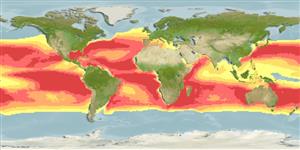Classification / Names
Common names from other countries
Main reference
Size / Weight / Age
Max length : 250 cm TL male/unsexed; (Ref. 30573); common length : 170 cm FL male/unsexed; (Ref. 9340); max. published weight: 83.0 kg (Ref. 168)
Length at first maturity
Lm 99.3, range 85 - 105 cm
Environment
Marine; pelagic-oceanic; oceanodromous (Ref. 51243); depth range 0 - 20 m (Ref. 89972), usually 0 - 12 m (Ref. 5227)
Climate / Range
Subtropical, preferred 27°C (Ref. 107945); 46°N - 37°S, 180°W - 180°E
Distribution
Short description
Dorsal
spines
(total): 23 - 27;
Dorsal
soft rays
(total): 12-16;
Anal
spines: 0;
Anal
soft rays: 12 - 14;
Vertebrae: 62 - 64. Mouth large with strong, triangular, compressed and finely serrate teeth. Snout about as long as the rest of head. Posterior part of maxilla completely concealed under preorbital bone. Gill rakers absent. Interpelvic process small and bifid. Swim bladder present. Body covered with small scales. No anterior corselet developed. The back is iridescent bluish green; the sides silvery with 24 to 30 cobalt blue vertical bars which extend to below the lateral line.
IUCN Red List Status (Ref. 115185)
Threat to humans
Reports of ciguatera poisoning (Ref. 30298)
Human uses
Fisheries: commercial; gamefish: yes
Tools
Special reports
Download XML
Internet sources
Estimates of some properties based on models
Phylogenetic diversity index
PD50 = 1.0000 many relatives (e.g. carps) 0.5 - 2.0 few relatives (e.g. lungfishes)
Trophic Level
4.3 ±0.2 se; Based on diet studies.
Resilience
Medium, minimum population doubling time 1.4 - 4.4 years (K=0.34; tm=1-2 y; tmax >4; Fec=6 million)
Vulnerability
Moderate to high vulnerability (46 of 100)
Price category
